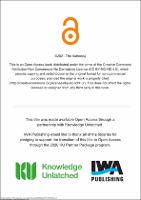Reservoir Eutrophication
Preventive Management: An applied example of Integrated Basin Management Interdisciplinary Research
| dc.contributor.author | Carneiro, Charles | |
| dc.contributor.author | Andreoli, Cleverson V. | |
| dc.contributor.author | Cunha, Cynara L. N. | |
| dc.contributor.author | Gobbi, Eduardo F. | |
| dc.date.accessioned | 2022-01-15T05:32:04Z | |
| dc.date.available | 2022-01-15T05:32:04Z | |
| dc.date.issued | 2014 | |
| dc.identifier | OCN: 898475077 | |
| dc.identifier.uri | https://library.oapen.org/handle/20.500.12657/52465 | |
| dc.description.abstract | The overall objective of Reservoir Eutrophication: Preventive Management is to present the environmental and anthropogenic factors associated with the process of eutrophication and algal blooms in the Rio Verde reservoir and propose lake use and management technologies in order to minimize the problem. Eutrophication process in Rio Verde reservoir with the occurrence of intense algal blooms is a consequence of the interconnection of different climatological, hydrological, morphological, physico-chemical and biological factors, which occur not only in the watershed but also in the reservoir. Reservoir Eutrophication: Preventive Management compiles the information gathered from the development of a broad research program in Rio Verde watershed, from 2008 until 2010. Rio Verde reservoir, which was built in 1976, is located in the Metropolitan Region of Curitiba, capital of the state of Paran? in South Brazil. This reservoir is mainly used for supplying water to one of PETROBRAS Refinery. However, the reservoir is to be used for supplying drinking water to the population and that is why better understanding this system dynamics is a great concern. The book is the result of an interdisciplinary research program, which has involved more than 150 researchers, with the aim of defining a watershed management preventive system in order to prevent eutrophication processes. This way, the book combines academic rigor with practical applicability and is of interest for both researchers and technologists working in watershed management. Reservoir Eutrophication: Preventive Management is of interest to researchers and technologists that wish to examine specific characteristics of tropical climates. It is of specific interest to developing countries and for researchers interested in knowing the developed methodology adapted for temperate conditions. | |
| dc.language | English | |
| dc.subject.classification | thema EDItEUR::T Technology, Engineering, Agriculture, Industrial processes::TQ Environmental science, engineering and technology::TQS Sanitary and municipal engineering::TQSW Water supply and treatment | en_US |
| dc.subject.other | Technology & Engineering | |
| dc.subject.other | Environmental | |
| dc.subject.other | Water Supply | |
| dc.title | Reservoir Eutrophication | |
| dc.title.alternative | Preventive Management: An applied example of Integrated Basin Management Interdisciplinary Research | |
| dc.type | book | |
| oapen.identifier.doi | https://doi.org/10.2166/9781780406480 | |
| oapen.relation.isPublishedBy | dc3cfe72-8424-48e6-b8e0-fca2844ba38e | |
| oapen.relation.isFundedBy | b818ba9d-2dd9-4fd7-a364-7f305aef7ee9 | |
| oapen.relation.isbn | 9781780406480 | |
| oapen.collection | Knowledge Unlatched (KU) | |
| oapen.imprint | IWA Publishing | |
| oapen.identifier | https://openresearchlibrary.org/viewer/7eacf57f-2362-41aa-a8fa-d0e07857d6d5 | |
| oapen.identifier.isbn | 9781780406480 |

